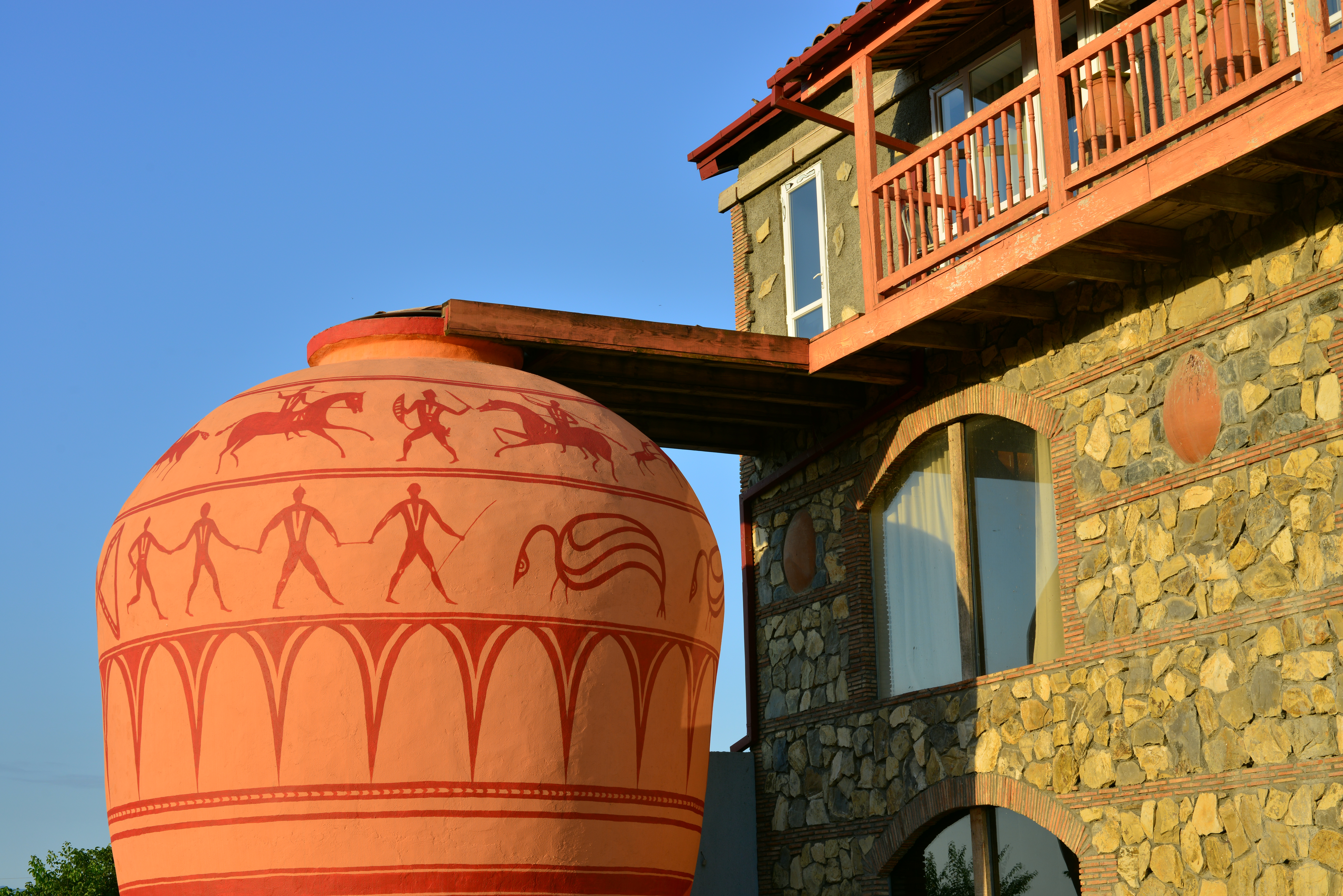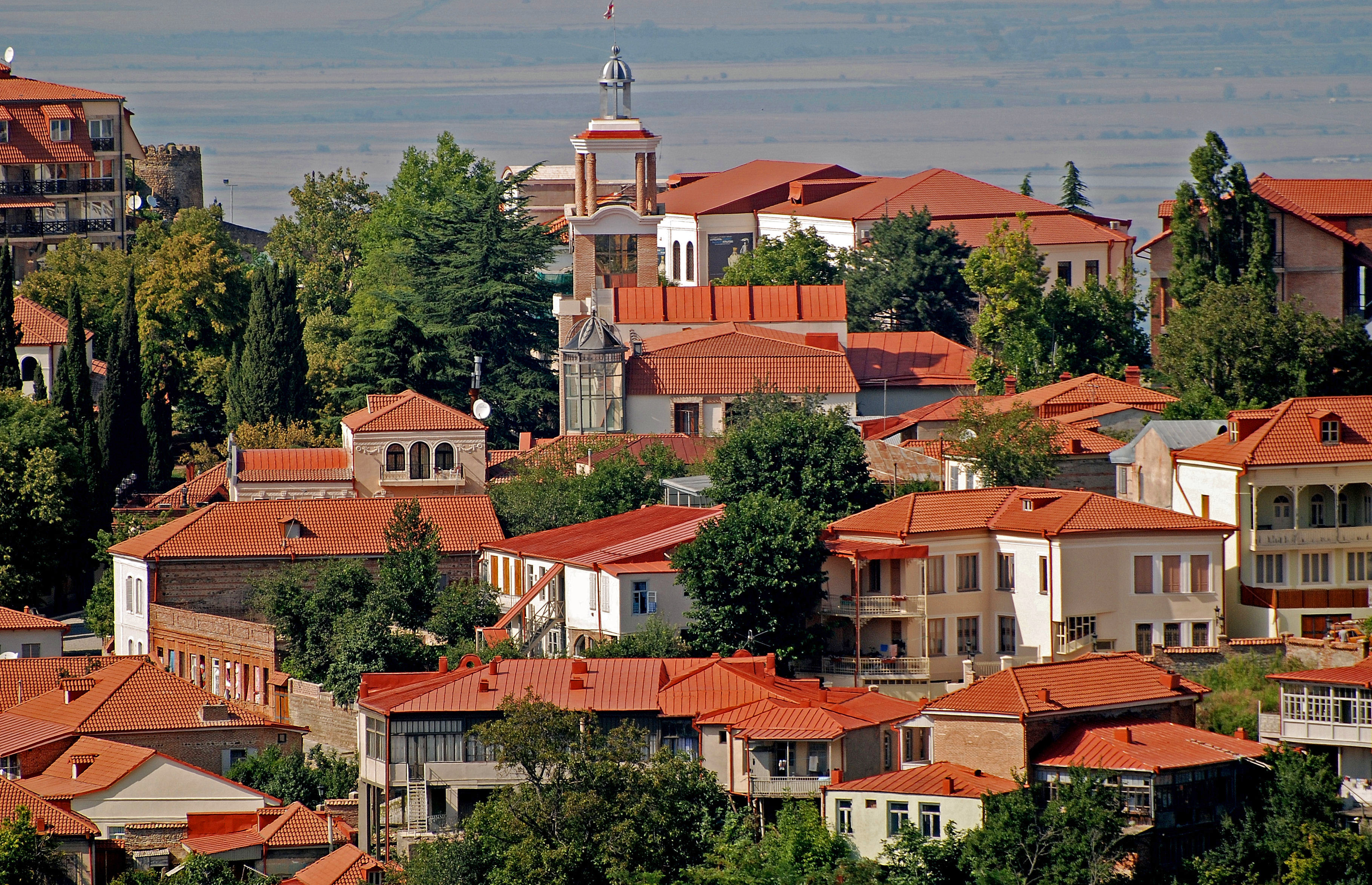|
Sighnaghi
Signagi or Sighnaghi ( ka, სიღნაღი) is a town in Georgia's easternmost region of Kakheti and the administrative center of the Signagi Municipality. Although it is one of Georgia's smallest towns, Signagi serves as a popular tourist destination due to its location at the heart of Georgia's wine-growing regions, as well as its picturesque landscapes, pastel houses and narrow, cobblestone streets. Located on a steep hill, Signagi overlooks the vast Alazani Valley, with the Caucasus Mountains visible at a distance. Etymology The name of the town comes from Old Turkic word of ' (, ), meaning "shelter" or "asylum". History Signagi is located in the Kakheti region of Georgia, first settled in the Paleolithic period. Throughout its history, Signagi or Sighnaghi was known to the local population as Kambechovani, and later as Kisikhi or Kisiki. The word ''Sighnaghi'' in the Turkic language means shelter or trench. Signagi as a settlement was first recorded in the early 1 ... [...More Info...] [...Related Items...] OR: [Wikipedia] [Google] [Baidu] |
Sighnaghi Municipality
Sighnaghi ( ka, სიღნაღის მუნიციპალიტეტი) is an administrative-territorial unit in eastern Georgia, Kakheti region. The municipality borders the municipalities of Gurjaani and Sagarejo to the northwest and west, the municipality of Dedoplistskaro to the southeast and the municipality of Lagodekhi and the Republic of Azerbaijan to the north and northeast. The area is 1251.7 km². Agricultural fields occupy 93,375 ha, and forest resources amount to 5,500 ha. History Until 1917, Sighnaghi municipality was called Sighnaghi Mazra; from 1928, the municipality was part of Kakheti Mazra, and from 1929 it was included in Kakheti District. Since 1930, it has been formed as a separate district. On July 9, 1938, according to the resolution of the Supreme Council of the Georgian SSR, the Sighnaghi district was separated from Tsiteltskaro district, and the remaining district was divided into the following rural councils: Sighnaghi (district centre ... [...More Info...] [...Related Items...] OR: [Wikipedia] [Google] [Baidu] |
Sighnaghi (სიღნაღი) (11)
Signagi or Sighnaghi ( ka, სიღნაღი) is a town in Georgia's easternmost region of Kakheti and the administrative center of the Signagi Municipality. Although it is one of Georgia's smallest towns, Signagi serves as a popular tourist destination due to its location at the heart of Georgia's wine-growing regions, as well as its picturesque landscapes, pastel houses and narrow, cobblestone streets. Located on a steep hill, Signagi overlooks the vast Alazani Valley, with the Caucasus Mountains visible at a distance. Etymology The name of the town comes from Old Turkic word of ' (, ), meaning "shelter" or "asylum". History Signagi is located in the Kakheti region of Georgia, first settled in the Paleolithic period. Throughout its history, Signagi or Sighnaghi was known to the local population as Kambechovani, and later as Kisikhi or Kisiki. The word ''Sighnaghi'' in the Turkic language means shelter or trench. Signagi as a settlement was first recorded in the early ... [...More Info...] [...Related Items...] OR: [Wikipedia] [Google] [Baidu] |
Georgian Wine
Georgia is the oldest wine producing region in the world. The fertile valleys and protective slopes of the South Caucasus were home to grapevine cultivation and neolithic wine production ( ka, ღვინო, ''ɣvino'') for at least 8000 years. Due to millennia of winemaking and the prominent economic role it retains in Georgia to the present day, wine and viticulture are entwined with Georgia's national identity. Among the best-known Georgian wine regions are Kakheti (further divided into the micro-regions of Telavi and Kvareli), Kartli, Imereti, Racha-Lechkhumi and Kvemo Svaneti, Adjara and Abkhazia. In 2013, UNESCO added the ancient traditional Georgian winemaking method using the Kvevri clay jars to the UNESCO Intangible Cultural Heritage Lists. History The roots of Georgian viticulture have been traced back by archeology to when people of the South Caucasus discovered that wild grape juice turned into wine when it was left buried through the winter in a shallow pi ... [...More Info...] [...Related Items...] OR: [Wikipedia] [Google] [Baidu] |
List Of Municipalities In Georgia (country)
A municipality ( ka, მუნიციპალიტეტი, tr) is a subdivision of Georgia, consisting of a settlement or a group of settlements (community, თემი, ''temi''), which enjoy local self-government. A total of 69 municipalities are registered as of January 2019. Five municipalities are entirely located in breakaway Abkhazia and South Ossetia, and are effectively not governed by Tbilisi. The remaining 64 are divided over five self-governing cities (ქალაქი, ''kalaki'') and 59 self-governing communities. Municipalities can be subdivided into administrative units, referred to as a community (თემი, ''temi''). Background The municipalities were first established in 2006. Most of them were successors to the earlier subdivisions, known as '' raioni'' (რაიონი), "districts". In addition, new municipalities were formed to govern those settlements in the disputed entities of Abkhazia and South Ossetia that at the time remained under G ... [...More Info...] [...Related Items...] OR: [Wikipedia] [Google] [Baidu] |
Politics Of Georgia (country)
Politics in Georgia involve a parliamentary representative democratic republic with a multi-party system. The President of Georgia is the ceremonial head of state and the Prime Minister of Georgia is the head of government. The Prime Minister and the Government wield executive power. Legislative power is vested in both the Government and the unicameral Parliament of Georgia. The Georgian state is highly centralized, except for the autonomous regions of Abkhazia and Adjara and the former autonomous region of South Ossetia. Abkhazia and South Ossetia, which had autonomy within the Georgian SSR during Soviet rule, unilaterally seceded from Georgia in the 1990s. While, , the Georgian government recognizes Abkhazia as autonomous within Georgia, it does not recognize South Ossetia as having any special status. Developments in 2003-2008 Following a crisis involving allegations of ballot fraud in the 2003 parliamentary elections, Eduard Shevardnadze resigned as president on November ... [...More Info...] [...Related Items...] OR: [Wikipedia] [Google] [Baidu] |
Kakheti
Kakheti ( ka, კახეთი ''K’akheti''; ) is a region ( mkhare) formed in the 1990s in eastern Georgia from the historical province of Kakheti and the small, mountainous province of Tusheti. Telavi is its capital. The region comprises eight administrative districts: Telavi, Gurjaani, Qvareli, Sagarejo, Dedoplistsqaro, Signagi, Lagodekhi and Akhmeta. Kakheti is bordered by the Russian Federation with the adjacent subdivisions ( Chechnya to the north, and Dagestan to the northeast), the country of Azerbaijan to the southeast, and with the regions of Mtskheta-Mtianeti and Kvemo Kartli to the west. Kakheti has a strong linguistic and cultural identity, since its ethnographic subgroup of Kakhetians speak the Kakhetian dialect of Georgian. The Georgian David Gareja monastery complex is partially located in this province and is subject to a border dispute between Georgian and Azerbaijani authorities. Popular tourist attractions in Kakheti include Tusheti, Gremi ... [...More Info...] [...Related Items...] OR: [Wikipedia] [Google] [Baidu] |
Georgia (country)
Georgia (, ; ) is a transcontinental country at the intersection of Eastern Europe and Western Asia. It is part of the Caucasus region, bounded by the Black Sea to the west, by Russia to the north and northeast, by Turkey to the southwest, by Armenia to the south, and by Azerbaijan to the southeast. The country covers an area of , and has a population of 3.7 million people. Tbilisi is its capital as well as its largest city, home to roughly a third of the Georgian population. During the classical era, several independent kingdoms became established in what is now Georgia, such as Colchis and Iberia. In the early 4th century, ethnic Georgians officially adopted Christianity, which contributed to the spiritual and political unification of the early Georgian states. In the Middle Ages, the unified Kingdom of Georgia emerged and reached its Golden Age during the reign of King David IV and Queen Tamar in the 12th and early 13th centuries. Thereafter, the ... [...More Info...] [...Related Items...] OR: [Wikipedia] [Google] [Baidu] |
Caucasian War
The Caucasian War (russian: Кавказская война; ''Kavkazskaya vojna'') or Caucasus War was a 19th century military conflict between the Russian Empire and various peoples of the North Caucasus who resisted subjugation during the Russian conquest of the Caucasus. It consisted of a series of military actions waged by the Russian Imperial Army and Cossack settlers against the native inhabitants such as the Adyghe, Abaza– Abkhaz, Ubykhs, Chechens, and Dagestanis as the Tsars sought to expand. Russian control of the Georgian Military Road in the center divided the Caucasian War into the Russo-Circassian War in the west and the conquest of Chechnya and Dagestan in the east. Other territories of the Caucasus (comprising contemporary eastern Georgia, southern Dagestan, Armenia and Azerbaijan) were incorporated into the Russian Empire at various times in the 19th century as a result of Russian wars with Persia. The remaining part, western Georgia, was taken b ... [...More Info...] [...Related Items...] OR: [Wikipedia] [Google] [Baidu] |
Soviet Union
The Soviet Union,. officially the Union of Soviet Socialist Republics. (USSR),. was a List of former transcontinental countries#Since 1700, transcontinental country that spanned much of Eurasia from 1922 to 1991. A flagship communist state, it was nominally a Federation, federal union of Republics of the Soviet Union, fifteen national republics; in practice, both Government of the Soviet Union, its government and Economy of the Soviet Union, its economy were highly Soviet-type economic planning, centralized until its final years. It was a one-party state governed by the Communist Party of the Soviet Union, with the city of Moscow serving as its capital as well as that of its largest and most populous republic: the Russian Soviet Federative Socialist Republic, Russian SFSR. Other major cities included Saint Petersburg, Leningrad (Russian SFSR), Kyiv, Kiev (Ukrainian Soviet Socialist Republic, Ukrainian SSR), Minsk (Byelorussian Soviet Socialist Republic, Byelorussian SSR), Tas ... [...More Info...] [...Related Items...] OR: [Wikipedia] [Google] [Baidu] |
Post-Soviet
The post-Soviet states, also known as the former Soviet Union (FSU), the former Soviet Republics and in Russia as the near abroad (russian: links=no, ближнее зарубежье, blizhneye zarubezhye), are the 15 sovereign states that were union republics of the Soviet Union, which emerged and re-emerged from the Soviet Union following its dissolution in 1991. Russia is the primary ''de facto'' internationally recognized successor state to the Soviet Union after the Cold War; while Ukraine has, by law, proclaimed that it is a state-successor of both the Ukrainian SSR and the Soviet Union which remained under dispute over formerly Soviet-owned properties. The three Baltic states – Estonia, Latvia, and Lithuania – were the first to declare their independence from the USSR, between March and May 1990, claiming continuity from the original states that existed prior to their annexation by the Soviet Union in 1940. The remaining 12 republics all subsequently seceded, a ... [...More Info...] [...Related Items...] OR: [Wikipedia] [Google] [Baidu] |
Mkhare
A ''mkhare'' ( ka, მხარე, ''mxare'') is a type of administrative division in the country of Georgia. It is usually translated as "region". According to presidential decrees in 1994 and 1996, Georgia's division into regions is on a provisional basis until the secessionist conflicts in Abkhazia and South Ossetia are resolved. The regional administration is headed by a State Commissioner (სახელმწიფო რწმუნებული, ''Saxelmćipo Rćmunebuli'', usually translated as "Governor"), an official appointed by the President. The regions are further subdivided into ''raionis'' (district A district is a type of administrative division that, in some countries, is managed by the local government. Across the world, areas known as "districts" vary greatly in size, spanning regions or counties, several municipalities, subdivisions o ...s). There are 9 regions in Georgia (see also map opposite): See also * Administrative divisions of Georgi ... [...More Info...] [...Related Items...] OR: [Wikipedia] [Google] [Baidu] |
_(11).jpg)


.jpg)
